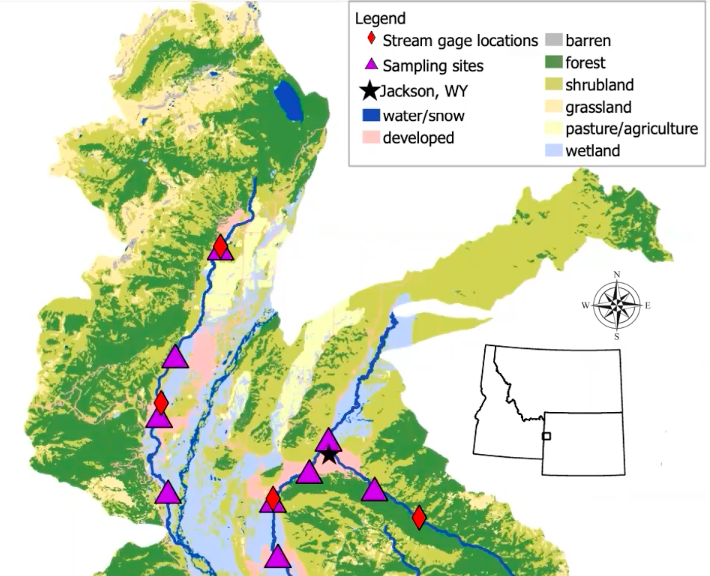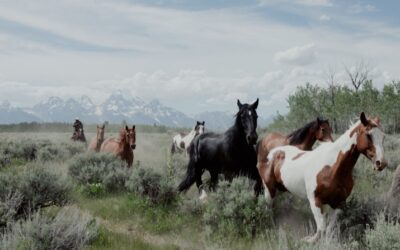Speaking during a Teton Conservation District meeting last month in front of a curious crowd of Jackson Hole residents was a new type of experience for Kelsey Ruehling in her master’s thesis process. Ruehling was presenting the final results of a study she started last year. And after months of crunching data, she was pleased with the response.
“I could tell from the level of questioning and, you know, even the clarifying questions of really trying to understand the science that is quite complicated and pretty nuanced, I could tell how much everybody really cares about this issue in Teton County,” she said.
When KHOL visited Ruehling during her fieldwork last summer, she was dipping a jar into Cache Creek trying to get a better understanding of the bacteria in the aquatic ecosystems of the area. Then, she compared her findings to samples of poop gathered from cattle, wildlife, dogs and human wastewater in Teton County.

Ruehling gathered samples from Fish, Flat, Cache and Game creeks in various Teton County locations. (Screenshot courtesy of Kelsey Ruehling)
One of the main goals of the project was to identify the greatest contributors to fecal (read: poop) contamination of Jackson Hole waterways. That’s often connected to certain harmful strains of E. coli, but it’s difficult to prove a direct connection.
The results of Ruehling’s study, she said, were a bit surprising and could be concerning for local officials.
The main takeaways from the study are that sewage is one of the major fecal contributors to Fish and Flat creek,” Ruehling said. “However, that is highly variable depending on the season.”
Now, there are a lot of caveats to that. A lot of the bacteria Ruehling sampled couldn’t be identified, and not all bacteria is a bad thingーwe all have plenty in our systems right now. But from what Ruehling could quantify, 32% of the fecal bacteria she could identify in Flat Creek came from human sewage. That number rose even higherーto 47%ーin Fish Creek.
“What I think is going on in these creeks is that, you know, septic systems or leaky sewer lines are depositing wastewater fecal bacteria or wastewater bacteria into the ground,” Ruehling said. “And then when groundwater comes up, it then flushes all of that wastewater bacteria into the surface water.”
The seasonal nature of Ruehling’s research is important for this finding. She saw high concentrations of bacteria from human waste during shoulder seasons, when there’s a lot of runoff. The same fluctuation wasn’t happening with the other two major contributors: Canine and cattle.
Ruehling said that just adds to her hypothesis because groundwater seeps into local creeks as snow melts in the spring or fall rains arrive. And a small amount of sewage can make a big difference.
“You can imagine that like even small quantities of wastewater being deposited into this like sparse kind of, you know, relatively microbial-poor surface waters could mean that it’s just, you know, those samples are overwhelmed,” she said.

Kelsey Ruehling (left), Emma Román (middle) and Clara Bouley (right) studied Flat, Game, Fish, and Cache creeks last summer. (Will Walkey/KHOL)
So, what does this all mean? For one, Ruehling said she’d be hesitant to recreate in Fish or Flat creeks, especially in the spring. But even last summer, the Teton County Department of Health put signs around those waterways warning of elevated levels of E. coli.
“It’s all a risk. It’s all associated with risk,” Ruehling said. “And the state and the EPA [U.S. Environmental Protection Agency] have designated those areas as being more risky for recreation in terms of public health.”
Moving forward, Ruehling said she hopes water managers in Jackson Hole use the new data in their policymaking. Making informed decisions is especially important considering how delicate Jackson Hole’s ecosystem isーand the fact that Jackson sits at the headwaters of the massive Snake River watershed.
“We all need to think about, like, we live upstream of somebody and so we could potentially be impacting the water not only for flows through our own community but in other places much further downstream,” Ruehling said.
“We have such little freshwater you know, on this Earth. And so at some point, like basically all of it will be recycled [and] will have been, you know, defecated in. And so, I think just thinking about what that means for our health, for the health of the rest of the ecosystem, is really important,” she added.
Local officials are also planning to ask the public for Specific Purpose Excise Tax (SPET) funding this fall to create a water quality master plan to improve the situation in problem areas like Hoback and Fish and Flat creeks. As for Ruehling, she’s accepted a job with the Wyoming Department of Environmental Quality in Sheridan, where she’ll keep focusing on environmental issues in the Cowboy State.





